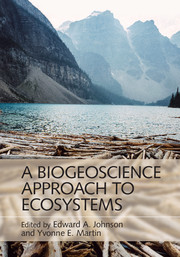Book contents
- Frontmatter
- Contents
- List of contributors
- Preface
- Miscellaneous Frontmatter
- 1 Introduction
- Part I Connecting Ecosystem and Geoscience Processes
- Part II Transport Processes and Conservation Budgets in Biogeoscience
- Part III Coupling Hillslope Geomorphology, Soils, Hydrology, and Ecosystems
- Part IV Coupling Fluvial and Aeolian Geomorphology, Hydrology/Hydraulics, and Ecosystems
- Index
- References
1 - Introduction
Published online by Cambridge University Press: 27 October 2016
- Frontmatter
- Contents
- List of contributors
- Preface
- Miscellaneous Frontmatter
- 1 Introduction
- Part I Connecting Ecosystem and Geoscience Processes
- Part II Transport Processes and Conservation Budgets in Biogeoscience
- Part III Coupling Hillslope Geomorphology, Soils, Hydrology, and Ecosystems
- Part IV Coupling Fluvial and Aeolian Geomorphology, Hydrology/Hydraulics, and Ecosystems
- Index
- References
Summary
The concept of ecosystem, like many ecological concepts that have come down to us from the early developments in ecology, has a rather elusive meaning. A. G. Tansley's (1935) original definition of ecosystem states: “the more fundamental conception is ‘as it seems to me’ the whole system (in the sense of physics) including not only the organism complex but the whole complex of physical factors we call the environment of the biome—the habitat factors in the widest sense.” However, “system” is never defined or further discussed so it is unclear what Tansley and his contemporaries understood it to mean. Did he mean simply that the abiotic and biotic were to be considered together as a unit unlike the more biologically focused concepts of community and biome? Or did he mean a more process-based approach, as in the physics of coupled systems of partial differential equations (i.e., coupled processes)? If the latter, how was this to be accomplished with no governing equations, such as the Navier–Stokes equations based on the conservation of three basic qualities – mass, energy, and momentum? Whatever Tansley meant initially, the ecosystem concept was subsequently used both as a classification of communities, biomes, and their habitat in terms of environmental factors and as nutrient cycles and energy flows through food webs (McIntosh, 1985). Thus, we are left with an incomplete understanding of how the environment is to be connected as a “system” to organisms, populations, communities, and ecosystems.
Recent decades have seen several advances that are contributing to the beginning of this synthesis (e.g., Nealson and Ghiorse, 2001; Hedin et al., 2002). One of the most interesting developments in ecology has been the Metabolic Theory of Ecology (MTE). This theory (West et al., 1997; 1999; Brown et al., 2004; Enquist et al., 2003; 2007) argues that mass conservation, biological mechanics, hydraulics, heat budgets, and thermodynamics can be used to explain the flux of energy, water, and nutrients from cells to ecosystems. This, in turn, explains the empirical scaling evidence for B = BoM3/4 where B is an organism's metabolic rate, Bo is a normalization constant independent of an organism's mass, and M is an organism's mass (West et al., 1997).
- Type
- Chapter
- Information
- A Biogeoscience Approach to Ecosystems , pp. 1 - 6Publisher: Cambridge University PressPrint publication year: 2016
References
- 1
- Cited by



